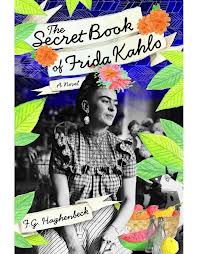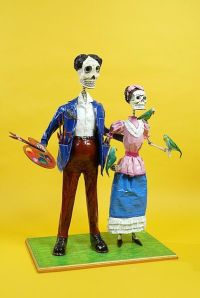Ironically, today marks the first day of the Mexican celebration The Day of the Dead, three days in which family and friends gather in many parts of the world, but especially traditional in Mexico, to acknowledge those that have died. Traditions include building an altar or shrine using sugar skulls, marigolds and the favourite foods and beverages of those who have passed, but are still remembered.
 The Day of the Dead has a special significance in the Mexican writer Francisco Haghenbeck’s novel The Secret Book of Frida Kahlo. Upon learning that several notebooks were found among Kahlo’s belongings, he imagines that one of them was given to Frida by her friend Tina Modotti and in it will capture recipes, memories and ideas that are inspired and connected to some of the noted people she spends time with.
The Day of the Dead has a special significance in the Mexican writer Francisco Haghenbeck’s novel The Secret Book of Frida Kahlo. Upon learning that several notebooks were found among Kahlo’s belongings, he imagines that one of them was given to Frida by her friend Tina Modotti and in it will capture recipes, memories and ideas that are inspired and connected to some of the noted people she spends time with.
“Among Frida Kahlo’s personal effects, there was a black book called “The Hierba Santa Book”. It contained a recipe collection for offerings on the Day of the Dead. According to tradition, on November 2 the departed have divine permission to return to earth, and they must be received with altars filled with Aztec marigolds, sweet pastries, photographs from long ago, religious postcards, mystically scented incense, playful sugar skulls and votive candles to illuminate their path to the next life.”
Frida Kahlo’s life story, her tomboyish, rebellious youth, her not so blind and yet all-embracing obsession with Diego Rivera, her accident, her art, her circle of friends both at home in Coyoacán, Mexico and those she fraternised with in the US and Europe are fascinating from almost any point of view, whether it’s the film Frida with Salma Hayek’s convincing role or Barbara Kingsolver’s fictional account of her in The Lacuna or this latest account with its superstitious bent.
The book started slowly, covering familiar ground and read a little like a summary of her early life, each chapter culminating in a recipe, like a tribute to the character who inhabited that episode. What makes it engaging and unique are Frida’s encounters with Death, who manifests as a man riding a horse and who visits her in the first few pages, before we even know who he is.
As well as this apparition of the carrier of death, it’s warning manifests through the presence of a woman she refers to as the Godmother, Empress of the Dead, one with whom Kahlo makes a pact, after the trolley-bus accident that almost kills her. She will live, but with a constant reminder of that which she has circumvented – death. She will extend her life and avoid death but must embrace pain. And thus she becomes even more superstitious than she might have been, carefully marking the annual Day of the Dead with her shrine and offerings, keeping that man on the horse from her door until she is ready for his presence.
“The pact she had with her Godmother had given her the courage to tell stories. She liked to joke about Death. She dared it, taunted it, knowing that somewhere, Death was listening.”
She possessed a fearless personality, though susceptible to pain and expressed it in her artwork with an intensity that some would find disturbing.
Pain is the recurring metaphor in Kahlo’s life, sometimes it was so physically present it disabled her for periods of time when painting was her only release. When it wasn’t physical pain she experienced, it was emotional, for even her husband Diego, the love of her life was a manifestation of pain, one she tried to eliminate, briefly divorcing him for a year, despairing of his continuous infidelities and then just as she accepted physical pain, she accepted her flawed husband and remarried him, deciding it was better to live with than without him.
Channelling her experiences onto canvas, she developed a unique style and following. She became as well-known and sought after as Diego, from New York to the surrealists in Paris, meeting people such as Georgie O’Keefe, Salvador Dali and back home in Mexico, she and Diego would become hosts to the exiled Leon Trotsky and his wife.
Each encounter in the book leads to a favourite dish she might have made for or shared with her friends and it is as if each dish is also a sacrifice to the Godmother, constantly fulfilling her pact to keep Death from her door.
An excellent addition to the collection of work that exists, with its unique focus on local tradition, superstition and Frida Kahlo’s pact with Death, remembered every year when she and Diego come visiting, as they will perhaps this November 2nd.
Note: This book was an Advance Read Copy (ARC) provided by the publisher via NetGalley.


